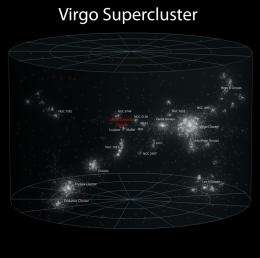January 31, 2012 report
Repulsive gravity as an alternative to dark energy (Part 1: In voids)

(PhysOrg.com) -- When scientists discovered in 1998 that the Universe is expanding at an accelerating rate, the possibility that dark energy could explain the observation was intriguing. But because there has been little progress in figuring out exactly what dark energy is, the idea has since become more of a problem than a solution for some scientists. One physicist, Massimo Villata of the National Institute for Astrophysics (INAF) in Pino Torinese, Italy, describes dark energy as “embarrassing,” saying that the concept is an ad hoc element to standard cosmology and is devoid of any physical meaning. Villata is one of many scientists who are looking for new explanations of the Universe’s accelerating expansion that involve some form of repulsive gravity. In this case, the repulsive gravity could stem from antimatter hiding in voids.
“Cosmic voids (and in particular the nearby Local Void) are observationally very well known and constitute the largest structures of which our Universe is composed,” Villata told PhysOrg.com. “The problem is whether they are really empty or contain the repulsive antimatter.”
In Villata’s paper, which will soon be published in Astrophysics and Space Science, he suggests that antimatter could be hiding in these large voids, separated from matter by mutual gravitational repulsion. As he explained previously, the gravitational repulsion between matter and antimatter is a prediction of general relativity. In this scenario, matter has a positive gravitational charge while antimatter has a (hypothetical) negative gravitational charge. As a result, both matter and antimatter are gravitationally self-attractive, yet mutually repulsive. The gravitational repulsion between matter and antimatter could be so powerful, in fact, that Villata has calculated that it could be responsible for the accelerated expansion of the Universe, eliminating the need for dark energy and possibly dark matter.
Repulsive gravity of this form could even theoretically explain some observations that dark energy cannot, even theoretically, explain. Recently, scientists observed an anomalous motion of the “Local Sheet,” the part of the Universe that includes the Milky Way and other nearby galaxies, which has its own peculiar velocity distinct from other parts of the Universe. Astronomers have identified three components that contribute to the velocity of the Local Sheet: one is due to the well-known attraction to the nearby dense Virgo Cluster; the second component, although its origin is less clear, is thought to be due to the attraction to the Centaurus Cluster; and the third component is what astronomers call the “local velocity anomaly” because the force is not directed toward any significant structure.
Unlike the first two components that are attractive, the third component could be repulsive, according to Villata. In support of this possibility, he notes that the Leo Spur galaxies, which would be located in between the Local Sheet and the attractive area, appear to be at rest with respect to this motion. Villata suggests that the origins of the third component may be on the opposite side, repelling the Local Sheet instead of attracting it. He calculates that a reasonable antimatter mass, located in a particular void, could account for the local velocity anomaly by the mechanism of repulsive gravity.
In this way, the antimatter would act like dark energy in our local neighborhood. On a large scale, numerous antimatter voids could drive the expansion of the Universe without the need for dark energy, and possibly even without the need for an explosive Big Bang (perhaps implying a cyclic Universe). The theory also implies that we live in a Universe with equal amounts of matter and antimatter, as expected by standard theories. To Villata, these results make repulsive gravity an alluring alternative to dark energy.
“Dark energy is thought to be uniformly permeating, so it can explain (formally, not physically) the global acceleration,” Villata said. “But it cannot explain either the strong repulsive effect on the Local Sheet nor the extreme emptiness of the Local Void and several other properties of our extragalactic neighborhood, while the proposed antimatter ‘dark repulsor’ in the Local Void can account for all these things and, at the global level, with antimatter hidden in all cosmic voids, can explain the overall accelerated expansion (and other Universe features) without dark energy and the funny initial explosion.”
Villata hopes these ideas might be tested by experiments, although such tests would be difficult.
“Some people may think that my analysis of general relativity predicting antigravity is not correct or appropriate,” he added. “In this case, a further, definitive test is mentioned in my last paper: the antigravitational lensing effect. In principle, if we had a good 3D map of galaxy clusters lying beyond the voids, it would be relatively easy to analyze whether some of them have shapes squeezed around the line of sight, which would mean that they are aligned with large concentrations of antimatter in the intervening void. But the problem is that there is another concurrent effect, which strongly distorts the distribution of galaxies in the radial direction, due to the peculiar motions affecting the redshift measurements: the finger-of-god effect, which stretches the shape of clusters along the line of sight. It is thus very difficult to distinguish whether a cluster already severely stretched by this effect is further thinned by antigravitational lensing.”
Part 2: Repulsive gravity as an alternative to dark energy (In the quantum vacuum)
More information: Massimo Villata. “’Dark Energy’ in the Local Void.” Astrophysics and Space Science. DOI: 10.1007/s10509-012-0994-9 and arXiv:1201.3810v1 [astro-ph.CO]
Website of Massimo Villata (comments welcome): link
Journal information: Astrophysics and Space Science
© 2011 PhysOrg.com




















